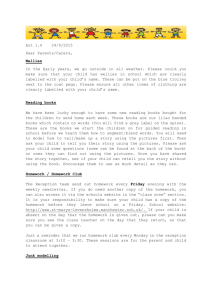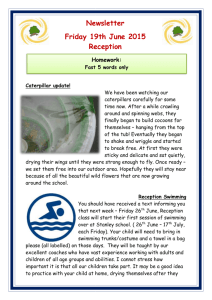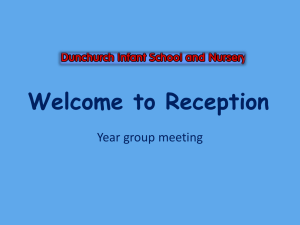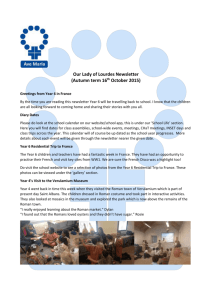Transition Policy
advertisement
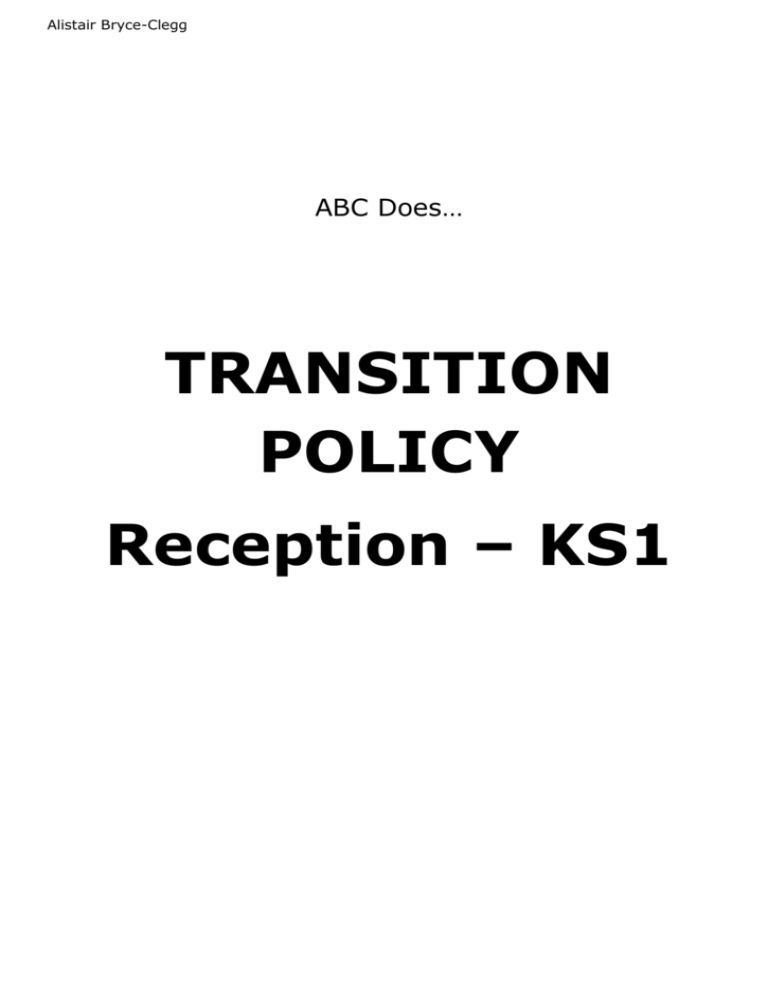
Alistair Bryce-Clegg ABC Does… TRANSITION POLICY Reception – KS1 Alistair Bryce-Clegg Contents Introduction Rationale Aims Equal Opportunities and Inclusion Principles that underpin the policy Initial Preparations Creating an appropriate environment Building on what children know and understand Partnership with Parents Continuing Professional Development Appendices Alistair Bryce-Clegg Introduction Excellence and Enjoyment discusses broadening and increasing the creativity within Key Stage One to meet the needs of young children. Extending the Foundation Stage curriculum into Key Stage One would address the advice given in this guidance, as well as meeting the needs of younger children as they progress through their learning. In this policy, ‘transition’ describes the movement that takes place from one year to the next, and in particular from one phase of education to the next within the school. This is different from ‘transfer’ which describes the movement from one school to the next. Rational At [insert school name] we feel it is important to create a whole school approach of which staff, children, parents, governors and other agencies have a clear understanding. This policy is a formal statement of intent for Reception to KS1 transition. The policy also facilitates how we meet the legal requirements of Education Acts and National Curriculum requirements. Aims We want our children to experience a smooth educational and emotional transition from one phase to the next. This will ensure that children make the best all round progress. Equal Opportunities and Inclusion The children and parents are actively involved in the process and their perceptions about transition are explored and valued. There are clear curriculum guidelines for children with learning difficulties Alistair Bryce-Clegg during transition. Appropriate assistance will be provided in a variety of ways including; A range of learning styles Using pupil’s ideas and motivations as a starting point for learning Adjusting the conceptual demand of the task as appropriate for the child. Principles that underpin the policy The principles that underpin our transition policy are Approaches to teaching and learning should be harmonised at the point of transition Planning should be based upon assessment information from the previous class/group/setting Styles of teaching and learning should meet the needs of children and not pre-conceived notions of what is or is not appropriate for the next phase/Key Stage There should be a professional regard for the information from the previous setting/phase Children’s emotional welfare, wellbeing and involvement should be assessed before and after transition. Children should enjoy the transition process The transition should motivate and challenge children Staff allocation for a period prior to, during and after initial transition should be made to maximise the comfort and welfare of the children. Effective transition takes time, and is a process rather than an event. Alistair Bryce-Clegg Parents and carers need to feel well informed about and comfortable with all transitions in their child’s life. Children, parents/carers and staff need to be involved on an equal basis. Transition is about the setting fitting the child, not the child fitting the setting. Transitions are not overlooked or left to chance, but thought about and planned in advance. Initial preparations Transitions are not overlooked or left to chance; good transition takes careful thought and thorough planning well in advance. All staff must be aware of the systems that are currently in place and build their review into the schools Self Evaluation schedule. Year One teachers to spend some designated time in Reception each term, observing children in their familiar environment and observing practice. Time is planned for termly meetings between Reception and Year One for teachers to discuss on going assessment and Profile information. Alistair Bryce-Clegg Reception, Year One teachers and the Assessment coordinator agree together what needs to be handed on at the end of the year. Reception children visit Year One a minimum of once per term. At least one joint project is planned between Reception and Year One each year. Arrangements are made for passing on information to parents about the transition to Year One. Reception parents are invited to meet the Year One teacher/support staff (where practicable) and explore the Year One environment. Reception teachers are given designated time to observe teaching practice in Year One at least once a term. Creating an appropriate environment Year One classroom has areas of continuous provision to support and extend children’s independence skills. All staff have received training on how to provide a high quality learning environment Year One staff have visited reception to see how areas of provision provide support and challenge for children’s current learning so that they can ensure future progress in the way they plan and organise their provision. The areas of provision in Year One are planned for appropriate learning objectives with more challenge and teacher focussed tasks Children in Year One have access to an outdoor learning environment to support teaching and learning. A richly resourced outdoor classroom is used to support teaching and learning in Year One. Alistair Bryce-Clegg Building on what children know and understand Areas of provision are planned for Year One, similar to those in Reception, but with appropriate challenge and adult directed activities. Support staff move temporarily with children/permanently with Reception children to their next class. Reception and Year One staff meet to discuss assessment information Reception teachers highlight those children who are still working at Foundation Stage level or may need a modified curriculum. Year One teachers will use cross phase planning that incorporates both Profile Scale Points and National Curriculum levels. Reception and Year One teachers meet in the latter part of the summer term to discuss the possible curriculum and environment for the first half term in Year One Teachers meet after the first few weeks in Year One to discuss individual children after the settling in period Throughout the year, Reception and Year One teachers occasionally teach each other’s classes to develop a greater understanding of children’s learning and gain knowledge about the curriculum. Partnership with parents At [school name] we encourage parents to be involved by: Inviting parents into school 3 times a year to discuss the progress of their child. Alistair Bryce-Clegg Inviting parents into school in the Summer term to discuss the annual report Inviting parents to curriculum evenings Half termly information booklets/newsletters to inform parents of curriculum coverage. Encouraging parents to come in and help in the classroom. [Add individual practice] Parents are informed in the Summer time about the class that their child will be in. Parents are given clear information about what to expect in Year One. Parents are given the opportunity to meet the Year One staff before September Parents are invited to experience the Year One environment, classroom layout and resources before September Reception parents are invited to help out in Year One Parents are invited to an information evening outlining what the National Curriculum is, and how best to support their child’s learning in Year One. Brief end of the day ‘open door’ sessions are offered to parents in the first few weeks of Year One to address any issues regarding their child settling into Year One. Continuing Professional Development Reception and Year One teachers know what the Early Years Foundation Stage Profile contains and how to interpret the scale points. Alistair Bryce-Clegg Reception and Year One teachers know how the Early Years Foundation Stage Curriculum links to the National Curriculum. Reception and Year One teachers are confident in making assessments through the observation of children Reception and Year One teachers plan collaboratively checking that continuity and progressions are evident from Reception to Year One. Professional development opportunities in relation to transition are evident in the School Improvement Plan. Alistair Bryce-Clegg Appendices Could include: A resources list A transition action plan Examples of Profile Point moderation References to appropriate relevant information Further Reference Seamless Transition: Supporting continuity in young people’s learning, Ref DFES – 0267 – 2006 Every Parent Matters, Ref LKAW/2007 Progress Matters – Reviewing and enhancing children’s development, Ref. 00217 – 2009BKT-EN The Impact of Parental Involvement on Children’s Education, Ref DCSF – 00924 - 2008 www.standards.dcfs.gov.uk www.teachernet.gov.uk/publications ‘Continuing the Learning Journey’ – supporting transition from Reception to Year One is available from QCA order line Tel: 08700 60 60 15 Order Number QCA/05/1590 ISBN 1-85838-720-5

